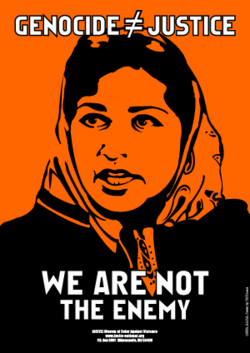Artist Favianna Rodriguez makes history with her politically conscious graphics company
Rodriguez produced her most popular piece, "We Are Not the Enemy," after the 9/11 attacks. She chose Meena, the founder of RAWA, for her image
by Momo ChangIf you went to college in the Bay Area during the mid-to-late-'90s, chances are you've seen Favianna Rodriguez work. She's the woman behind many of the ubiquitous peace and protest posters displayed on college campuses and in storefront windows, championing such issues as "No on Prop. 209" (the anti-affirmative action initiative) and demanding ethnic studies education.
She projects her radical messages onto high-contrast, boldly outlined figures, but she's not just someone who rants and raves in a fist-in-the-air kind of way. The 27-year-old is clearheaded and visionary about her art. Though she follows in the traditions of Chicano poster-makers of the '60s and '70s, like Malaquías Montoya of Sacramento and the artists at Mission Cultural Center for Latino Arts' Mission Grafica (2868 Mission, SF. 415-821-1155), she came of age in the digital era, when hundreds of posters can be designed and printed overnight.
Digital designing allows her company, Tumi's Designs (3028 International, Oakl. 510-532-8267), to have a fast turnaround, which is important in these politically turbulent times. Rodriguez – who works out of a small but efficient Oakland office on the border of the Fruitvale and San Antonio districts, not far from where she grew up – says, "Everything we do revolves around the vision that we want a socially just world."
At the same time, she also knows art and politics should appeal to the masses, and – as is the case with much of Tumi's work – youth. "We're competing with MTV, Nike, and Vibe. It has to look tight. It has to be slick." For the past four years, her company has been designing posters, Web sites, brochures, and flyers for community organizations like the Media Action Center for the Youth Media Council.
 Rodriguez produced her most popular piece, "We Are Not the Enemy," immediately after the 9/11 attacks. Anticipating that Middle Eastern women would be targeted for hate crimes, Rodriguez chose Meena, the Afghan founder of the Revolutionary Association of the Women of Afghanistan (RAWA), for her image. She worked in collaboration with Incite! Women of Color Against Violence, who paid Rodriguez a nominal fee for her design and for all of the offset-printing costs. Within a few days, Incite! had mailed 10,000 copies of the poster to schools, nonprofits, and its New York, Chicago, Minneapolis, and Los Angeles chapters, where members were gearing up for protests of the US bombing of Afghanistan. As a result, Meena's determined gaze became a dominant symbol of antiwar sentiment seen all across the country.
Rodriguez produced her most popular piece, "We Are Not the Enemy," immediately after the 9/11 attacks. Anticipating that Middle Eastern women would be targeted for hate crimes, Rodriguez chose Meena, the Afghan founder of the Revolutionary Association of the Women of Afghanistan (RAWA), for her image. She worked in collaboration with Incite! Women of Color Against Violence, who paid Rodriguez a nominal fee for her design and for all of the offset-printing costs. Within a few days, Incite! had mailed 10,000 copies of the poster to schools, nonprofits, and its New York, Chicago, Minneapolis, and Los Angeles chapters, where members were gearing up for protests of the US bombing of Afghanistan. As a result, Meena's determined gaze became a dominant symbol of antiwar sentiment seen all across the country.
Not all of Rodriguez's work is mass-produced. One of her prints, along with two pieces by her longtime colleague, Jesus Barraza – whom she met while on the art team of UC Berkeley's Chicano newspaper, "La Voz" - is showcased in the new book The Design of Dissent (Rockport Publishers), which features the best political art spanning the '60s to the present. Rodriguez's contribution is a stirring portrait of Kyung Hae Lee, a 56-year-old South Korean rice farmer and union activist who stabbed and killed himself in protest of the World Trade Organization's agricultural policies. Compelled to address how the mainstream media portrayed the farmer's suicide as a shameful act, Rodriguez worked on the project solo, making a limited-edition run through the traditional silkscreening process. Though it wasn't widely circulated, it's now an important document of our political history.
While maintaining a successful for-profit business with a wide range of progressive clients, the team will be expanding later this year into the new EastSide Arts Alliance space (2285 International, Oakl.), a nonprofit collective of artists and organizers dedicated to art for social change that Rodriguez cofounded. At the center, Tumi's co-owner, Estria Miyashiro, who got his start two decades ago as a graffiti artist, now leads a group of teenagers through a program called Visual Elements. The youth group creates authorized public art projects like the colorful murals depicting jazz musicians and hip-hop artists outside the ESAA and the mural at the Excelsior Boys and Girls Club in San Francisco.
Having undertaken so many valuable projects, it's not surprising Tumi's artists are receiving recognition. This month, the Los Angeles-based Center for the Study of Political Graphics is honoring Rodriguez and Barraza for creating Taller Tupac Amaru, a silk-screening collective based in a San Leandro warehouse.
Putting together all their posters, flyers, and mailers highlights some of the most important issues of the past decade. "It's an entire timeline of people's struggles from 1996 until now. In the present poster-making is a tool, but when you move forward, it's like us writing our history," Rodriguez says.
From: http://www.sfbg.com
[Home] [RAWA in the Media] [Books on RAWA]